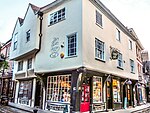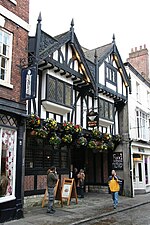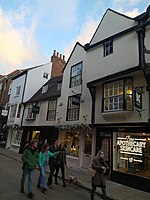Masonic Hall, Duncombe Place

The Masonic Hall is a historic building on Duncombe Place in York, in England. The building was designed by J. Barton-Wilson and John Edwin Gates and was completed in 1863. It was altered in 1866, and a large extension was added in the early 20th century. It is of two storeys, with a basement beneath. The original building, including the masonic hall itself, is of grey brick, while the extension is red brick. The entrance is now through the extension. The front has a moulding depicting masonic symbols. The library has 18th century panelling and a fireplace of similar date. The hall is home to several masonic lodges, including the York Lodge, founded as the Union Lodge in 1777. From 1806, the lodge was based at 7 Little Blake Street, but that property was demolished when Duncombe Place was constructed, and the current hall was then built. The building is the oldest purpose-built masonic hall in the city.The building was grade II listed in 1997.
Excerpt from the Wikipedia article Masonic Hall, Duncombe Place (License: CC BY-SA 3.0, Authors, Images).Masonic Hall, Duncombe Place
Duncombe Place, York Bishophill
Geographical coordinates (GPS) Address Nearby Places Show on map
Geographical coordinates (GPS)
| Latitude | Longitude |
|---|---|
| N 53.96137 ° | E -1.08394 ° |
Address
Duncombe Place
YO1 7DX York, Bishophill
England, United Kingdom
Open on Google Maps











